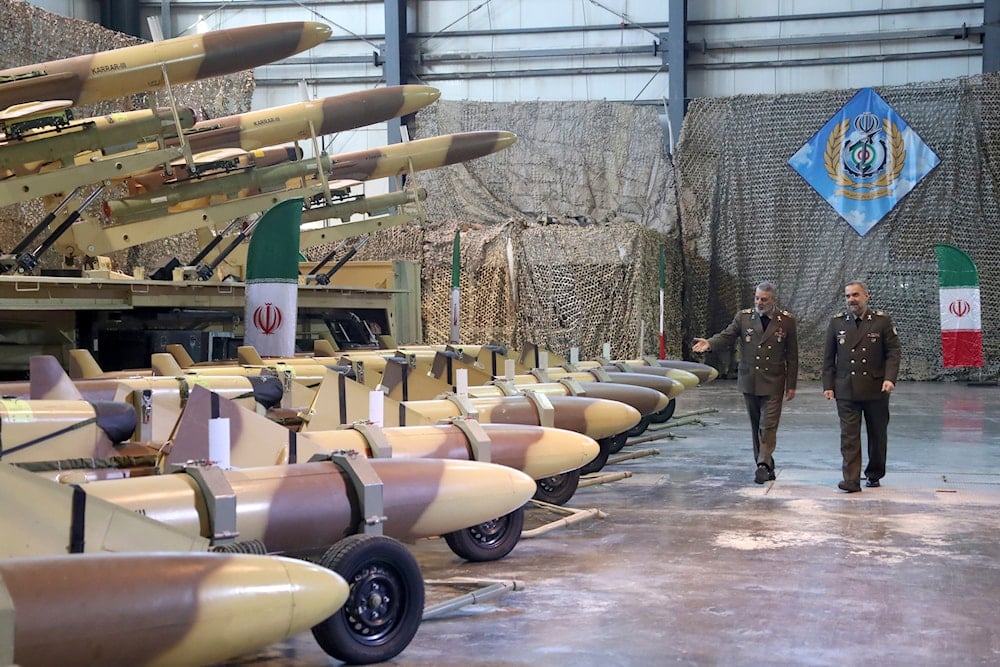'Iran leaving fingerprints everywhere' has become a curse for US: WSJ
Iran now ranks as the world’s 16th-biggest arms seller in 2022 with $123 million in exports, up from $20 million in 2017.
-

On Jan. 23, 2024, army commander Gen. Abdolrahim Mousavi and Defense Minister Gen. Mohammad Reza Gharaei Ashtiani review domestically-built drones (Iranian Defense Ministry via AP)
Iran's rise in the world of arms supply has become a nightmare for the US and its allies, as it coincides with the intensification of the war on Gaza.
The US alleges that a Shahid suicide drone, one of Iran’s top arms exports, was used to kill three American troops in Jordan last month by Iraqi fighters. On the same day, the US Coast Guard confiscated over 200 shipments of weapons allegedly originating from Iran and bound for Yemen. A couple of days later, Sabrina Singh, the US Deputy Pentagon Press Secretary, said, "We're assessing the drone," which falls way short of establishing a standard of proof for Iran's alleged responsibility for the attack.
The US doesn't have the facts, but they're sure Iran is responsible for the attack that targeted the US forces in the Jordanian-Syrian border area.
— Al Mayadeen English (@MayadeenEnglish) January 30, 2024
Going from "we know that Iran is behind it" to "we know that Iran certainly plays a role with these groups [responsible]", the US… pic.twitter.com/AAC7ruS3k5
The US Central Command (CENTCOM), responsible for US military operations in the Middle East, stated that included parts for missiles and underwater and surface drones. Iran has previously denied being involved in arming Yemen.
The US also claims in an investigation by the Defense Intelligence Agency that models of Shahid drones have been used by Yemeni Armed Forces (YAF) and by Russia in its war in Ukraine, despite repeated Iranian denials.
Back in November, Deputy Defense Minister Mahdi Farahi stated that around $1 billion in weapons from March 2022 to March 2023 were sold - three times as much as the previous year.
According to the Stockholm International Peace Research Institute after its release of a tally that omits smuggled weapons, Iran now ranks as the world’s 16th-biggest arms seller in 2022 with $123 million in exports, up from $20 million in 2017 when Iran was the 33rd.
Adam Rousselle, a researcher at the Militant Wire, a network of experts that examines weapons used by nonstate actors, said, “By exporting these technologies and proving their efficacy in battle, Iran has likely changed the nature of asymmetric warfare forever, potentially giving substantial leverage to previously disadvantaged nonstate actors,” adding, “The consequences… could be disastrous for major powers around the world.”
Read more: Strategic cruise missiles, choppers join Iranian Navy fleet
US officials continue to allege, as cited by the WSJ, that Russia intends to buy short-range ballistic missiles from Iran.
Challenging the embargo
The WSJ report takes it back to the 1980s when Iran’s defense industry grew following a US-imposed arms embargo on the newly born Islamic Republic. According to Iran’s Fars news agency, they were used chiefly for reconnaissance.
The flourished Iran’s weapons-export industry has been a source of revenue in a country isolated by sanctions that impede its ability to sell oil and carry out most banking transactions.
Iran’s drone expertise was best manifested in Moscow enlisting Tehran last year to help build a Russian factory that could produce at least 6,000 drones a year, part of a $1 billion deal between the two countries, WSJ reported.
Iranian drones have, in fact, exhibited a leap in engineering, becoming more accurate through improvements in radio communications, onboard computers, and measurement tools, according to Conflict Armament Research, a UK-based investigative organization, as reported by WSJ.
To sum up, Saeid Golkar, an authority on Tehran’s security services at the University of Tennessee at Chattanooga, said, “Iran is leaving its fingerprints all over the place," which is infuriating the US.

 3 Min Read
3 Min Read








